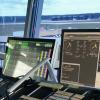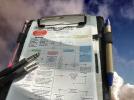Jett8 B742 at Singapore on Dec 17th 2009, uncontained engine failure
Singapore's Air Accident Investigation Bureau (SAAIB) released their final report concluding the probable causes of the serious incident was:
- The uncontained engine failure was a result of the circumferential fracture of the S3 LPT disk forward spacer arm. The failure is consistent with the engine having sustained vibration due to HP rotor imbalance.
- The operator’s documentation system, as regards its evaluation of its EHM contractor’s maintenance-related recommendations, was such that its decision making process was not always clearly recorded.
- The operator did not update the engine manufacturer on changes to the names and contact details of the persons within the operator’s organisation responsible for liaising with the engine manufacturer on safety information.
- It was not a practice of the engine manufacturer to ascertain whether the operators indeed received the pertinent safety information that it had sent out to them.
The SAAIB reported the aircraft departed Singapore's runway 02C and was cleared to climb to FL240 when at about 7000 feet the crew heard a muffled bang and noticed the odour of oil in the cockpit. The flight engineer (67, FEL, 14,600 hours total, 11,500 hours on type) noticed the oil pressure and oil quantity rapidly reduced on engine #4, the N1 and N2 rotor speeds reduced but did not drop to zero, the EGT remained within permitted limits. The crew decided to shut the engine down and advised ATC. The captain (56, ATPL, 11,200 hours total, 2,450 hours on type), so far pilot monitoring, assumed role as pilot flying, the first officer (37, ATPL, 3,495 hours total, 418 hours on type) became pilot monitoring. The aircraft returned to Singapore for a safe landing on runway 02C. A post flight inspection revealed engine #4 had suffered an uncontained failure, there was no evidence of fire.
Further examination showed engine inlet and low pressure compressor were intact, there was no indication of foreign object damage/ingestion.
The high pressure compressor stage 1 to stage 8 showed damage consistent with stator case rubbing. One blade at stage 9 was missing from about one inch from the blade platform, two stage 10 blades were missing half of the airfoil, too. Heavy impact damage was observed on stage 10 to stage 14 high pressure compressor blades.
The combustion chambers appeared intact.
2 of the high pressure turbine stage 1 blades were missing more than half of their airfoils, thirteen other stage 1 blades were found with nicks, oxidation and cracks. 79 stage 2 blades were found broken.
The low pressure turbine's stage 3 nozzle guide vane was exposed, the whole of the low pressure turbine rotor, all blade sections and the aft of the turbine rotor were missing from the engine. The stage 1 and 2 blades showed damage consistent with stator case outer shroud rubbing.
A number of turbine blade debris was recovered from both halves of the engine cowl and engine pylon, the bulk cargo door and the right side of the vertical stabilizer was punctured, there were multiple dents and punctures on the underside of the right hand wing, an underwing fuel tank control panel was punctured causing some fuel leakage.
The SAAIB analyzed that a circumferential fracture of the stage 3 low pressure turbine disk forward spacer arm led to the uncontained failure of the engine and continued: "A number of previous S3 LPT disk failures were attributed to vibration due to HP rotor imbalance caused by HPT rotor blade airfoil material loss. The investigation team believes that the S3 LPT disk failure in the 17 December 2009 occurrence is consistent with the engine having sustained vibration due to HP rotor imbalance. The vibration and rotor imbalance aspects of this and other similar S3 LPT disk failure cases are being investigated in detail by the engine manufacturer and the NTSB."
With respect to engine health monitoring the SAAIB analyzed that increasing exhaust gas temperatures and fuel flow were typical indications of deterioration and performance loss of the high pressure rotor, e.g. loss of air blade material or blade surface contamination. The SAAIB stated: "The initial shifting of No.4 engine EGT upwards without increase in fuel flow had probably led the operator to believe that it could be a case of EGT indication fault. However, one would expect that the repeated recommendations by the EHM contractor for a BSI made on 3, 5 and 10 December 2009 should be sufficient to alert the operator that there was an engine problem. Although the operator eventually scheduled for the EGT indication check and BSI as recommended by its EHM contractor and engineering handling agent, these maintenance actions were postponed subsequently. The operator considered that the EHM contractor’s recommendations were not mandatory. However, it is unclear how the operator evaluated the risk of engine-related failures if the EHM contractor’s recommendations were not carried out."
The SAAIB continued: "The operator said it was in compliance with the procedures approved by the regulatory authority. However, in the course of the investigation, the investigation team had asked the operator for information pertaining to its system of reviews of maintenance action recommendations made by the EHM contractor, i.e. its system defining how and by whom the recommendations were processed and the follow-up decisions made. The investigation team was not provided with clear documented evidence pertaining to the operator’s review system. With the current emphasis on safety management system, an air operator is expected to have a robust safety management system, including comprehensive documentation on its various maintenance programmes (including, for example, EHM)."
As safety action the NTSB issued an urgent safety recommendation in May 2010, see NTSB issues urgent safety recommendations regarding CF6 engines, the engine manufacturer introduced a new design stage 3 low pressure turbine disk, the FAA followed up with Airworthiness Directives in March 2010, June 2010, February 2011, August 2011 and January 2012 introducing increased monitoring and inspection as well as reducing life limits of the old design low pressure turbine stage 3 rotor and introduced a draw plan to remove old design disks from service.
3 additional safety recommendations to improve documentation and information flow were issued as result of the investigation.
The damaged engine, intact engine in overlay (Photos: SAAIB):
The puncture of the vertical stabilizer (Photo: SAAIB):
http://avherald.com/h?article=4288e1ec/0000














Komentarze